Related Research Articles

Girolamo Aleandro was an Italian cardinal, and the first cardinal appointed in pectore.
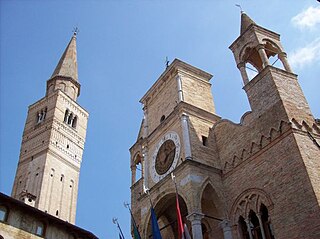
Pordenone is the main comune of Pordenone province of northeast Italy in the Friuli Venezia Giulia region.

Alvise or Luigi Vivarini (1442/1453–1503/1505) was an Italian painter, the leading Venetian artist before Giovanni Bellini. Like Bellini, he was part of a dynasty of painters. His father was Antonio Vivarini and his uncle, with whom he may have trained, was Bartolomeo Vivarini. Another uncle, on his mother's side, was the artist known as Giovanni d'Alemagna, who worked with his brother-in-law Antonio. Alvise may have trained Jacopo de' Barbari.
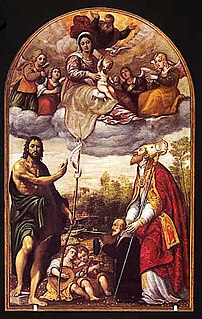
Pomponio Amalteo was an Italian painter of the Venetian school.

St. Sebastian is the subject of three paintings by the Italian Early Renaissance master Andrea Mantegna. The Paduan artist lived in a period of frequent plagues; Sebastian was considered protector against the plague as having been shot through by arrows, and it was thought that plague spread abroad through the air.

Pordenone, Il Pordenone in Italian, is the byname of Giovanni Antonio de’ Sacchis, an Italian Mannerist painter, loosely of the Venetian school. Vasari, his main biographer, wrongly identifies him as Giovanni Antonio Licinio. He painted in several cities in northern Italy "with speed, vigor, and deliberate coarseness of expression and execution—intended to shock".

Spilimbergo is a comune with a population of 11,961, located in the Friuli-Venezia Giulia region, in northern Italy, on the right side of the Tagliamento river. The town is notable as the home of the Mosaic School of Friuli, which was founded in 1922 and has students from all over the world.

Venzone is a comune (municipality) in the Province of Udine in the Italian region of Friuli-Venezia Giulia.

Casarsa della Delizia, simply known as Casarsa, is a comune (municipality) in the Province of Pordenone in the Italian region Friuli-Venezia Giulia, located about 80 kilometres (50 mi) northwest of Trieste and about 15 kilometres (9 mi) east of Pordenone.

San Vito al Tagliamento is a comune (municipality) in the Province of Pordenone in the Italian region Friuli Venezia Giulia, located about 80 kilometres (50 mi) northwest of Trieste and about 20 kilometres (12 mi) southeast of Pordenone.

Sesto al Reghena is a comune (municipality) in the Province of Pordenone in the Italian region Friuli-Venezia Giulia, located in the lower Friulian-Venetian plain about 80 kilometres (50 mi) northwest of Trieste and about 20 kilometres (12 mi) southeast of Pordenone.
Giovanni Maria Zaffoni was an Italian painter of the Renaissance period, active in Northern Italy near his natal city of Pordenone.
Andrea di Bertholotti of Cividale was an Italian painter and a master in the Guild of San Vito in 1462. He seems to have contracted for altar-pieces and mural decorations in Udine, San Vito and the surrounding towns, up to 1490. At the Palazzo Communale of Udine is a Crucifixion (1476). The sacristy of Santa Maria di Castello in San Vito possesses by him a Virgin and Child, between SS. Peter and Paul, dated 1488. In Savorgnano is a Madonna (1490).

Girolamo Alibrandi (1470-1524), was an Italian painter, born and active in Sicily, called the Raphael of Messina.
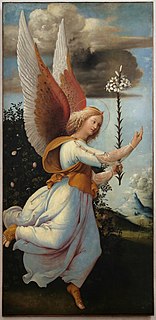
Fra Girolamo Bonsignori, was an Italian artist.
Girolamo di Tiziano, also known as Girolamo Dante or Girolamo Dente, flourished at Venice from 1550 to 1580. It is said that in copying the originals of his master, he attained so high a degree of excellence, that such of his pieces as were retouched by Titian, bid defiance often to the judgment of the most expert connoisseurs. He also produced works of his own design; the altar-piece attributed to him at San Giovanni Nuovo, representing SS. Cosmo and Damianus, reflects credit on the school to which he belonged.

Girolamo Aleandro, the younger was a very distinguished Italian scholar. His grand-uncle Girolamo Aleandro, the elder (1480–1542) is better known and was the first cardinal appointed in pectore.
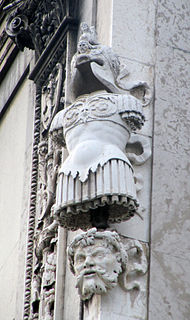
Gasparo Cairano, also known as Gasparo da Cairano, de Cayrano, da Milano, Coirano, and other variations, was an Italian sculptor of the Renaissance.
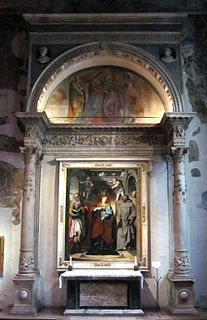
The Altar of San Girolamo is a sculptural complex in marble, around 780×450×80cm in dimension, designed and constructed by Gasparo Cairano and Antonio Medaglia, and situated within the Church of St Francis of Assisi in Brescia, Italy. Dated between 1506–1510, it is located in the first chapel on the right side of the nave.
References
- 1 2 3 Bryan,1886-9
- ↑ "Pomponio Amalteo (Motta di Livenza 1505–1588 San Vito al Tagliamento)". Princeton University Art Museum.
- ↑ Zani, Pietro (1819). Enciclopedia metodica critico-ragionata delle belle arti. Vol. 2. Parma. p. 279.